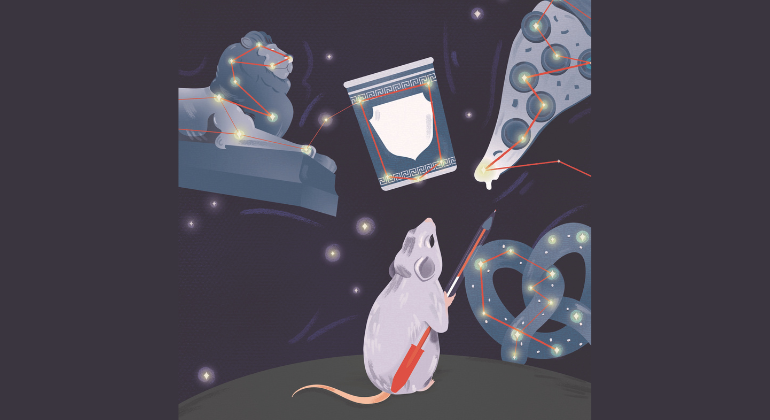Mount Sinai Researchers Have Uncovered the Mechanism in the Brain That Constantly Refreshes Memory

New research shows how the brain reactivates different memories to link them across time.
Credit: Stellate Communications
Mount Sinai researchers have discovered for the first time a neural mechanism for memory integration that stretches across both time and personal experience. These findings, reported in Nature [https://doi.org/10.1038/s41586-024-08168-4], demonstrate how memories stored in neural ensembles in the brain are constantly being updated and reorganized with salient information, and represent an important step in deciphering how our memories stay current with the most recently available information. This discovery could have important implications for better understanding adaptive memory processes (such as making causal inferences) as well as maladaptive processes (such as post-traumatic stress disorder, or PTSD).
“The long-held view is that memories are formed during initial learning and remain stable in neural ensembles over time, enabling us to recall a particular experience,” says Denise Cai, PhD, Associate Professor of Neuroscience at the Icahn School of Medicine at Mount Sinai and senior author of the study. “Our work with mouse models shows the inadequacy of this theory, since it doesn’t account for how the brain can both store memories while flexibly updating them with new and relevant information. This combination of stability and flexibility within neural ensembles is critical for us to make everyday predictions and decisions, and to interact with an ever-changing world.”
The fundamental question of how we dynamically update memories as we encounter fresh information has continued to challenge neuroscientists. For their study, the Mount Sinai team tracked the behavior and neural activity in the hippocampus of adult mice as they learned new experiences, rested after each experience (during so-called “offline” periods), and recalled past memories in the following days. Researchers found that after each event, the brain consolidates and stabilizes the memory by replaying the experience. After a negative experience, the brain replays not just that event, but memories from days earlier, seemingly searching for related events to link together and, therefore, integrate memories across time.
The study of mice that experienced a highly adverse event (e.g., receiving an foot shock in a specific environment), revealed that negative experiences drove reactivation of not only the recent adverse memory, but also of a “neutral,” or non-threatening, memory formed days earlier (a safe and different environment where they did not receive any shocks). “We learned that when mice were resting after a highly negative experience, they simultaneously reactivated the neural ensemble of that experience and the past neutral memory, thus integrating the two distinct memory modalities,” explains Dr. Cai. “We refer to this phenomenon as ensemble co-reactivation, and now know that it drives the long-term linking of memories in the brain.”
Contrary to published literature showing how sleep seems to benefit memory storage, researchers found that memory linkage occurred more often while mice were awake than asleep. This finding raised interesting questions for the team about the distinct roles that wakefulness and sleep play in different memory processes. The research also showed that adverse experiences were more likely to be linked with past memories, or “retrospectively,” than “prospectively” across days, and that more intense negative events were more likely to drive retrospective memory-linking.
“In discovering a complex neural mechanism that facilitates memory integration, we’ve taken a major step in the direction of better understanding real-world memory, where we know that our memories are constantly being updated and remodeled with subsequent experience so that we can function day-to-day in a dynamic world,” said Dr. Cai.
About the Mount Sinai Health System
Mount Sinai Health System is one of the largest academic medical systems in the New York metro area, with 48,000 employees working across seven hospitals, more than 400 outpatient practices, more than 600 research and clinical labs, a school of nursing, and a leading school of medicine and graduate education. Mount Sinai advances health for all people, everywhere, by taking on the most complex health care challenges of our time—discovering and applying new scientific learning and knowledge; developing safer, more effective treatments; educating the next generation of medical leaders and innovators; and supporting local communities by delivering high-quality care to all who need it.
Through the integration of its hospitals, labs, and schools, Mount Sinai offers comprehensive health care solutions from birth through geriatrics, leveraging innovative approaches such as artificial intelligence and informatics while keeping patients’ medical and emotional needs at the center of all treatment. The Health System includes approximately 9,000 primary and specialty care physicians and 10 free-standing joint-venture centers throughout the five boroughs of New York City, Westchester, Long Island, and Florida. Hospitals within the System are consistently ranked by Newsweek’s® “The World’s Best Smart Hospitals, Best in State Hospitals, World Best Hospitals and Best Specialty Hospitals” and by U.S. News & World Report's® “Best Hospitals” and “Best Children’s Hospitals.” The Mount Sinai Hospital is on the U.S. News & World Report® “Best Hospitals” Honor Roll for 2025-2026.
For more information, visit https://www.mountsinai.org or find Mount Sinai on Facebook, Instagram, LinkedIn, X, and YouTube.